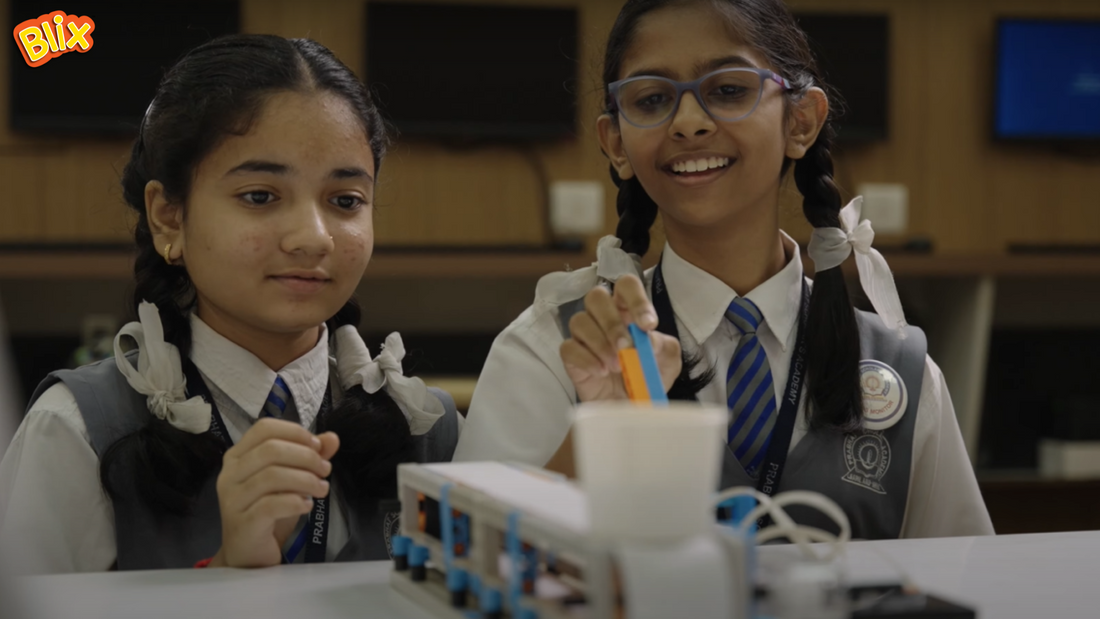
STEM Lab for School Set Up in India as per NEP 2020 Guidelines
Share

The National Education Policy (NEP) 2020 has given major importance to STEM education. And that's why even schools are readily interested in integrating STEM labs.
STEM tinkering labs are spaces that allow kids to experiment and innovate freely. And more than this, become active problem solvers and not just passive learners. Wondering how? Let's first understand,
Why do Schools Need a STEM Lab as per NEP 2020?
India’s goal right now is to create a tech-savvy generation. And integration of STEM labs best aligns with this goal. In addition to this, here are some more reasons why schools should invest in a STEM lab setup:
- More experiential learning happens here through hands-on activities
- Kids solve problems and think analytically
- STEM labs prepare students and actually build a strong foundation for careers in robotics, AI, and STEM fields
- Allows kids to collaborate, create, and think logically
To support this, Blix Robotics provides structured robotics labs for schools in India. Everything that we offer best aligns with NEP 2020 standards. And also our kits are STEM-accredited and BIS-certified.
But,What are the major components of a STEM lab for schools?
Now let's get into the main part. What goes into setting up an actual STEM lab in a school, here are the complete process, prerequisites, and also the components required:
1. Understanding the NEP 2020 Framework
The National Education Policy (NEP) 2020 gives more focus to experiential learning. STEM is even a part of it. If a school wants to go for a robotics lab, kids actually get hands-on experience with STEM, AI, and Robotics concepts.
2. Infrastructure and Space Requirements
To establish a STEM tinkering lab, schools should allocate a dedicated space of at least 400 sq. ft. Some other essentials of the lab are:
- Workstations. There must be tables for electronics, AI, and robotics experiments.
- A good digital infrastructure. Schools must have computers with i5 processors, 8GB RAM, and a minimum 50Mbps internet connection.
- Proper storage: There must be cabinets for robotics kits, STEM kits, and accessories.
- A good multimedia support. There should be projectors or smart screens to make learning more interactive.
3. Selecting the Right STEM and Robotics Kits
A robotics lab for school should include age-appropriate kits.
For ages 11-14, that is grades 6-8, schools can go for advanced STEM kits like boffin set, block coding set, or electronics set to make them understand difficult concepts like coding,and circuits easily.
For age groups 8-11, that is grades 3-5, schools can try out screen-free and foundational STEM kits. They can try out logic blocks, motions, and mechanisms, or discover electricity sets to make them aware of concepts like basic coding and circuits.
For age groups 5-7, that is grades 1-2, playful and story-driven STEM kits work best. Schools can give Queaky (junior electricity) and Blix junior (a simple construction set) a try.
Now, let's say you're confused about how the curriculum ahead will go, with the integration of these kits? NEP has replaced the 10+2 structure, with a 5+3+3+4 structure. And at Blix, we have done the groundwork for too many schools.
At Blix, we offer
- Curriculum that matches the school's curricula
- Our curriculum is designed for Grades 1-8, with 30 sessions per grade
- It aligns with core subjects like Physics, Math, and Computer Science
- It is designed for ALL students rather than only for the interested 5%
- We also support schools in organizing intra-school Blix-A-Thon competitions
- We even offer a Learning Management System (LMS). It allows schools to track progress, and get access to the best of digital resources.
4. Teacher Training and Support
A STEM lab requires well-trained educators to guide students. At Blix,:
- We do the research part. We look for teachers based on their skills at a specific locality
- We take the interviews and do the background check
- After they qualify for our Blix programme, we share the lead with the school for the second round of interview
- If the school approves, we train the teacher under our teaching programme, and they receive a certificate entitled 'Blix Certified Trainer'.
5. Implementation Process
Here's the step-by-step process for setting up a STEM lab for schools:
- Purchasing the right kit and setting up the infrastructure
- Delivery of the lab equipment
- Teachers' training and placement
- Commencement of the program
- Quarterly audits of the lab and the trainers.
Lastly, we even offer ongoing support to schools. Starting from maintenance, audits, spare parts review, and software updates. We do it all.
By following these steps, schools can establish a state-of-the-art STEM lab that best aligns with NEP. So, are you ready to help our future innovators, innovate the right way? Contact us now!
